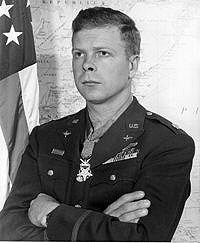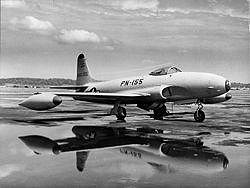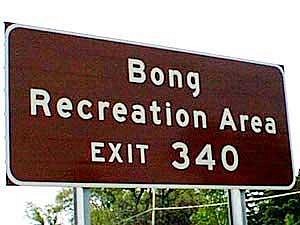Beyond Tiki, Bilge, and Test / Bilge / Tiki Bong Fan Club
Post #543353 by woofmutt on Sun, Jul 18, 2010 10:48 PM
|
W
woofmutt
Posted
posted
on
Sun, Jul 18, 2010 10:48 PM
*Bong, the son of Swedish immigrant parents, grew up on a farm in Poplar, Wisconsin as one of nine children. He became interested in aircraft at an early age and was a keen model builder. He began studying at Superior State Teachers College in 1938. While there, Bong enrolled in the Civilian Pilot Training Program and also took private flying lessons. In 1941 he enlisted in the Army Air Corps Aviation Cadet Program. One of his flight instructors was Capt. Barry Goldwater (later Senator from Arizona and unsuccessful 1964 presidential candidate). Bong's ability as a fighter pilot was recognized at training in northern California. He received his wings and commission as a second lieutenant on January 9, 1942, and became a gunnery instructor. Bong's first operational assignment was to the 49th Fighter Squadron (FS), 14th Fighter Group at Hamilton Field, California, where he transitioned into the twin-engine P-38 Lightning. On June 12, 1942, Bong flew very low over ("buzzed") a house in nearby San Anselmo, the home of a pilot who had just been married. He was cited and temporarily grounded for breaking flying rules, along with three other P-38 pilots who had looped around the Golden Gate Bridge on the same day. For looping the Golden Gate Bridge, for flying at low level down Market Street in San Francisco and for blowing the clothes off of an Oakland woman's clothesline, Bong was reprimanded by General George C. Kenney, commanding officer of the Fourth Air Force, who told him, "If you didn't want to fly down Market Street, I wouldn't have you in my Air Force, but you are not to do it any more and I mean what I say." Kenney later wrote: "We needed kids like this lad." In all subsequent accounts, Bong denied flying under the Golden Gate Bridge. Nevertheless, Bong was still grounded when the rest of his group was sent without him to England in July 1942. Bong then transferred to another Hamilton Field unit, 84th Fighter Squadron of the 78th Fighter Group. From there Bong was sent to the Southwest Pacific Area. On September 10, 1942, Lt. Bong was assigned to the 9th Fighter Squadron (aka "Flying Knights"), 49th Fighter Group, based at Darwin, Australia. While the squadron waited for delivery of the scarce Lockheed P-38s, Bong and other 9th FS pilots flew missions with the 39th FS, 35th Fighter Group, based in Port Moresby, New Guinea, to gain combat experience. On December 27, 1942, Bong claimed his initial aerial victory, shooting down a Mitsubishi A6M "Zero" and an Nakajima Ki-43 "Oscar" over Buna (during the Battle of Buna-Gona). For this action Bong was awarded the Silver Star. In March 1943 Bong returned to the 49th FG, now at Schwimmer Field near Port Moresby, New Guinea. On July 26, 1943, Bong shot down four Japanese fighters over Lae, an accomplishment that earned him the Distinguished Service Cross. While on leave to the United States in November and December 1943, Bong met Marge Vattendahl at a Superior State Teachers' College Homecoming event and began dating her. After returning to the Southwest Pacific in January 1944, he named his P-38 "Marge" and adorned the nose with her photo. By April 1944, Captain Bong had shot down 27 Japanese aircraft, surpassing Eddie Rickenbacker's American record of 26 credited victories in World War I. After another leave in the U.S. in May 1944, Major Bong returned to New Guinea in September. Though assigned to the V Fighter Command staff and not required to fly combat missions, Bong continued flying from Tacloban, Leyte, during the Philippines campaign, increasing his official air-to-air victory total to 40 by December. Upon the recommendation of Far East Air Force commander General George Kenney, Bong received the Medal of Honor from General Douglas MacArthur in a special ceremony in December 1944. Bong's Medal of Honor citation states that he flew combat missions despite his status as an "instructor", which was one of his duties as standardization officer for V Fighter Command. His rank of major would have qualified him for a squadron command, but he always flew as a flight (four-plane) or element (two-plane) leader. In January 1945, General Kenney sent America's ace of aces home for good. Bong married Marge and participated in numerous PR activities, such as promoting the sale of war bonds. Ironically, Bong considered his gunnery accuracy to be poor, so he compensated by getting as close to his targets as possible to make sure he hit them. In some cases he flew through the debris of exploding enemy aircraft, and on one occasion actually collided with his target, which he claimed as a "probable" victory. Bong was killed in 1945 while testing a P-80A similar to this one...
On August 6, 1945, the plane's primary fuel pump malfunctioned during takeoff on the acceptance flight of P-80A 44-85048. Bong either forgot to switch to the auxiliary fuel pump, or for some reason was unable to do so. Bong cleared away from the aircraft, but was too low for his parachute to deploy. The plane crashed into a narrow field at Oxnard St & Satsuma Ave, North Hollywood. His death was front-page news across the country, sharing space with the first news of the bombing of Hiroshima. At the time of the crash, Bong had accumulated four hours and fifteen minutes of flight time (totaling 12 flights) in the P-80. The I-16 fuel pump was a later addition to the plane (after an earlier fatal crash) and Bong himself was quoted by Captain Ray Crawford (another P-80 test/acceptance flight pilot who flew the day Bong was killed) as saying that he had forgotten to turn on the I-16 pump on an earlier flight. Bong is buried in a Poplar, Wisconsin cemetery. Bong is the namesake of the Bong State Recreation Area on the site of what was to be Bong Air Force Base in southeastern Wisconsin
There are Bong avenues on the former site of the decommissioned Richards-Gebauer Air Force Base, on Lackland AFB in San Antonio, Texas, on Luke AFB in Glendale, Arizona and on Elmendorf AFB in Anchorage, Alaska. In Mount Holly Township, New Jersey, Bong Terrace is named for him. On September 24, 2002 the Bong Veterans Historical Center (originally the Bong 'World War II Heritage Center') opened to the public in Superior, Wisconsin. Housed in a structure intended to resemble an aircraft hangar, it contains a museum, a film screening room, and a P-38 Lightning restored to resemble Bong's plane.* |



